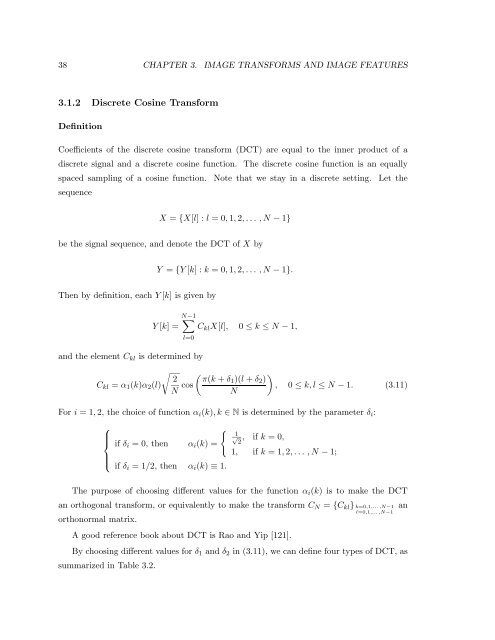sparse image representation via combined transforms - Convex ...
sparse image representation via combined transforms - Convex ...
sparse image representation via combined transforms - Convex ...
Create successful ePaper yourself
Turn your PDF publications into a flip-book with our unique Google optimized e-Paper software.
38 CHAPTER 3. IMAGE TRANSFORMS AND IMAGE FEATURES<br />
3.1.2 Discrete Cosine Transform<br />
Definition<br />
Coefficients of the discrete cosine transform (DCT) are equal to the inner product of a<br />
discrete signal and a discrete cosine function. The discrete cosine function is an equally<br />
spaced sampling of a cosine function. Note that we stay in a discrete setting. Let the<br />
sequence<br />
X = {X[l] :l =0, 1, 2,... ,N − 1}<br />
be the signal sequence, and denote the DCT of X by<br />
Y = {Y [k] :k =0, 1, 2,... ,N − 1}.<br />
Then by definition, each Y [k] is given by<br />
Y [k] =<br />
N−1<br />
∑<br />
l=0<br />
and the element C kl is determined by<br />
C kl = α 1 (k)α 2 (l)<br />
C kl X[l], 0 ≤ k ≤ N − 1,<br />
√<br />
2<br />
N cos ( π(k + δ1 )(l + δ 2 )<br />
N<br />
)<br />
, 0 ≤ k, l ≤ N − 1. (3.11)<br />
For i =1, 2, the choice of function α i (k),k ∈ N is determined by the parameter δ i :<br />
⎧<br />
⎪⎨<br />
⎪⎩<br />
if δ i = 0, then<br />
{<br />
√2 1<br />
, if k =0,<br />
α i (k) =<br />
1, if k =1, 2,... ,N − 1;<br />
if δ i =1/2, then α i (k) ≡ 1.<br />
The purpose of choosing different values for the function α i (k) istomaketheDCT<br />
an orthogonal transform, or equivalently to make the transform C N = {C kl } k=0,1,... ,N−1 an<br />
l=0,1,... ,N−1<br />
orthonormal matrix.<br />
A good reference book about DCT is Rao and Yip [121].<br />
By choosing different values for δ 1 and δ 2 in (3.11), we can define four types of DCT, as<br />
summarized in Table 3.2.
















